List of Serb countries and regions
List of Serb countries and regions refers to the states, regions and other entities, contemporary and historical, which have been founded by Serb elite.
| Part of a series of articles on |
| Serbs |
|---|
 |
History
The "medieval Serbian lands" included Serbian tribes, polities and monarchies, such as Raška, Serbian Empire, etc.[1]
In 1857, while traveling across "Ancient Serbia", Alexander Hilferding (1831-1872), a Russian Slavist and travel writer of German origin, wrote: "an Orthodox Serb, wherever he might live – in Bosnia, Herzegovina, Dalmatia, Hungary, Principality of Serbia – has, besides a church, one great homeland, Serbian land, which is, to tell the truth, divided among many masters, but it exists as an ideal, as the land of the unified Orthodox Serbian nation. He has his own oral tradition, folklore; he knows about Serbian Saint Sava, Serbian Emperor Dušan, Serbian martyr Lazar, popular hero Prince Marko. His current life rests upon the foundations of his nation and it is permeated with the previous historical life of the nation".[2]
The term was used by political theorist Dobrica Ćosić and other Serbian politicians during the Yugoslav wars (1991–95) as an argument and a call for the ethnic unification of all Serbs through union with Serbia into one country, whether they lived in Montenegro, Bosnia and Herzegovina (today Republika Srpska) or Croatia (former Republic of Srpska Krajina).[3]Liberal Serbs saw Ćosić as one of the key people behind the Greater Serbia project.[4]
Middle Ages
| Image | Map | Name | Years | Notes |
|---|---|---|---|---|
 |
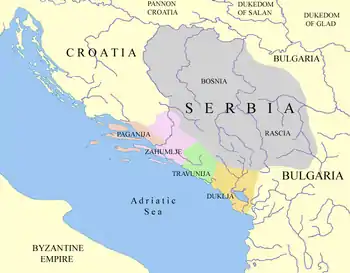 |
Serbian Principality | 7th century-969 | Principality of Serbia (Serbian: Кнежевина Србија / Kneževina Srbija) was one of the early medieval states of the Serbs, located in western regions of Southeastern Europe. It existed from the 8th century up to c. 969-971 and was ruled by the Vlastimirović dynasty. Its first ruler known by name was Višeslav who started ruling around 780. In 822, the Serbs were said to rule the "greater part of Dalmatia", while at the same time the Bulgars had taken the lands to the east, preparing to conquer Serbia. |
 |
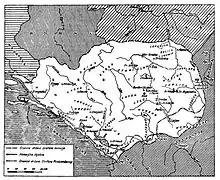 |
Principality of Rascia | 1091-1217 | Raška (Serbian Cyrillic: Рашка, Latin: Rascia) was a Serb medieval state that comprised parts of what is today Serbia, Montenegro, Bosnia and Herzegovina, and southern Dalmatia, being centred in the region of Raška (hence its exonym). The state was formed in ca. 1091 out of a vassal principality of Duklja, a Serb state which had itself emerged from the early medieval Serbian Principality that was centred in Raška until 960, when it was left in obscurity in sources after the Byzantine–Bulgarian wars. Its founder, Vukan, took the title of Grand Prince when his uncle and overlord Constantine Bodin ended up in Byzantine prison after decades of revolt. While Duklja was struck with civil wars, Raška continued the fight against the Byzantines. It was ruled by the Vukanović dynasty, who managed to put most of the former Serbian state under their rule, as well as expanding to the south and east. |
 |
Serbian Kingdom | 1217-1346 | The Kingdom of Serbia (Serbian: Краљевина Србија / Kraljevina Srbija), or Serbian Kingdom (Српско краљевство / Srpsko kraljevstvo), was a medieval Serbian state that existed from 1217 to 1346, ruled by the Nemanjić dynasty. The Grand Principality of Serbia was elevated with the coronation of Stefan Nemanjić as king by his brother, archbishop Sava, after inheriting all territories unified by their father, grand prince Stefan Nemanja. The kingdom was proclaimed an empire on 16 April 1346. | |
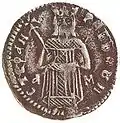 |
 |
Kingdom of Syrmia | 1282–1325 | Kingdom of Syrmia was a medieval Serb kingdom. Initially, it was a vassal kingdom of the Kingdom of Hungary, but subsequently became an independent kingdom, after the collapse of the central power in the Kingdom of Hungary. It was ruled by the Serbian kings Stefan Dragutin (1282–1316) and his son Stefan Vladislav II (1316–1325). The kingdom was centered in the region of Lower Syrmia (today known as Mačva) and its first capital was Debrc (between Belgrade and Šabac), while residence of the king was later moved to Belgrade. |
 |
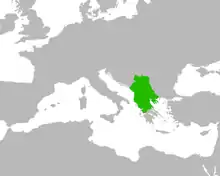 |
Serbian Empire | 1346-1371 | The Serbian Empire (Serbian: Српско царство/Srpsko carstvo, pronounced [sr̩̂pskoː tsâːrstʋo]) is a historiographical term for the empire in the Balkan peninsula that emerged from the medieval Serbian Kingdom. It was established in 1346 by King Stefan Dušan, known as "the Mighty", who significantly expanded the state. Under Dušan's rule Serbia was the major power in the Balkans, and a multi-lingual empire that stretched from the Danube to the Gulf of Corynth, with its capital in Skopje. He also promoted the Serbian Archbishopric to the Serbian Patriarchate. His son and successor, Uroš the Weak, lost most of the territory conquered by Dušan, hence his epithet. The Serbian Empire effectively ended with the death of Uroš V in 1371 and the break-up of the Serbian state. |
 |
Empire of Simeon Uroš | 1359-1373 | Simeon Uroš (Serbian Cyrillic: Симеон Урош, Greek: Συμεών Ούρεσης; c. 1326–1370), nicknamed Siniša (Синиша), was a self-proclaimed Emperor of Serbs and Greeks, from 1356 to 1370. He was son of Serbian King Stefan Dečanski and Byzantine Princess Maria Palaiologina. Initially, he was awarded the title of despot in 1346, and appointed governor of southern Epirus and Acarnania in 1347 by his half-brother, Serbian Emperor Stefan Dušan. After Dušan's death in 1355, Serbian throne passed to Dušan's son Stefan Uroš V, but despot Simeon decided to seize the opportunity in order to impose himself as co-ruler and lord of all southern provinces of the Serbian Empire. That led him to conflict with his nephew in 1356, when Simeon started to expand his control in southern regions of the Empire, trying to take Thessaly and Macedonia. He proclaimed himself Emperor of the Serbs and Greeks, creating a separate state, centered in regions of Thessaly and Epirus, where he ruled until death in 1370. He was succeeded by his son Jovan Uroš. | |
 |
Despotate of Thomas Preljubović | 1366-1385 | Thomas Preljubović (Serbian: Тома Прељубовић / Toma Preljubović; Greek: Θωμάς Κομνηνός Παλαιολόγος, Thōmas Komnēnos Palaiologos) was ruler of the Despotate of Epirus in Ioannina from 1366 to his death on December 23, 1384. He also held the title of Albanian-slayer (Ἀλβανοκτόνος). He was succeeded by his wife Maria Angelina. | |
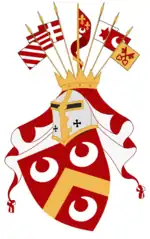 |
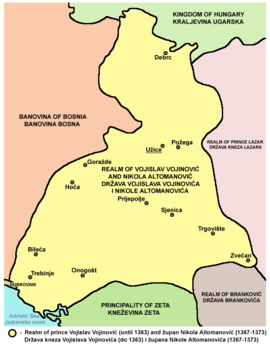 |
Nikola Altomanović Domain | 1371-1373 | Nikola Altomanović (Serbian Cyrillic: Никола Алтомановић) was a 14th-century Serbian župan of the House of Vojinović. He ruled the areas from Rudnik, over Polimlje, Podrinje, east Herzegovina with Trebinje, till Konavle and Dračevica, neighboring the Republic of Dubrovnik. He was defeated and blinded in Užice (fortress Užice) in 1373 by a coalition of his Serbian and Bosnian royals neighbors supported by the king of Hungary. |
 |
 |
Dejanović Domain | 1371-1395 | The Dejanović (Serbian Cyrillic: Дејановић, pl. Dejanovići / Дејановићи) or Dragaš (Serbian Cyrillic: Драгаш, pl. Dragaši / Драгаши), originates from a medieval noble family that served the Serbian Empire of Dušan the Mighty (r. 1331-1355) and Uroš the Weak (r. 1355-1371), and during the fall of the Serbian Empire, after the Battle of Maritsa (1371), it became an Ottoman vassal. The family was one of the most prominent during these periods. The family held a region roughly centered where the borders of Serbia, Bulgaria and Macedonia meet. The last two Byzantine Emperors were maternal descendants of the house. |
 |
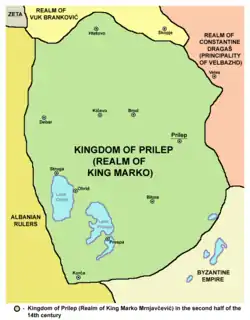 |
Kingdom of Prilep | 1371-1395 | The Lordship of Prilep, also known as the Realm of King Marko (Serbian: Област краља Марка / Oblast kralja Marka), was one of the successor-states of the Serbian Empire, covering (mainly) the southern regions, corresponding (in modern terms) to western parts of present-day North Macedonia. Its central region of Pelagonia, with the city of Prilep, was held by lord Vukašin Mrnjavčević, who in 1365 became Serbian king and co-ruler of Serbian emperor Stefan Uroš V (1355-1371). After king Vukašin died at the Battle of Maritsa in 1371, the realm was obtained by his son and designated successor (rex iunior) Marko Mrnjavčević, who took the title of Serbian king. At that time, capital cities of the Serbian realm were Skopje and Prizren, but during the following years king Marko lost effective control over those regions, and moved his residence to Prilep. He ruled there until his death in the Battle of Rovine in 1395. By the end of the same year, the Realm of late King Marko was conquered by Ottoman Turks. |
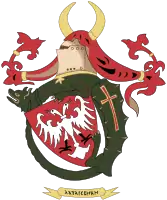 |
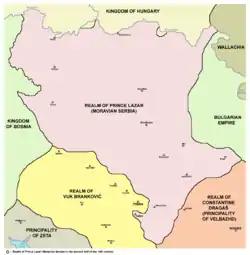 |
Moravian Serbia | 1371-1402 | Moravian Serbia (Serbian: Моравска Србија / Moravska Srbija) is the name used in historiography for the largest and most powerful Serbian principality to emerge from the ruins of the Serbian Empire (1371). Moravian Serbia is named after Morava, the main river of the region. Independent principality in the region of Morava was established in 1371, and attained its largest extent in 1379 through the military and political activities of its first ruler, prince Lazar Hrebeljanović. In 1402 it was raised to the Serbian Despotate, which would exist until 1459. |
 |
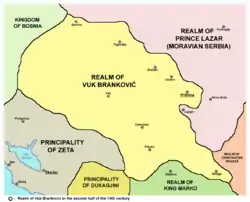 |
Branković Domain | 1371-1412 | The District of Branković (Serbian: Земља Бранковића, Zemlja Brankovića) or Vuk's land (Serbian: Вукова земља, Vukova zemlja) was one of the short lived semi-independent states that emerged from the collapse of the Serbian Empire in 1371, following the death of the last Emperor Uroš the Weak (1346-1371). The founder of this realm was Vuk Branković, the son of sebastokrator Branko Mladenović who governed Ohrid under Stefan Dušan the Mighty (1331-1346). Through Vuk's marriage with Mara, the daughter of Moravian Serbia's Prince Lazar, he was given substantial lands to govern in Kosovo. |
 |
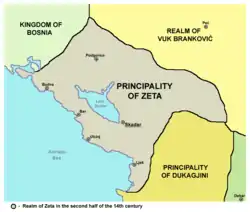 |
Zeta under the Balšići | 1371-1421 | Zeta (Serbian Cyrillic: Зета) was one of the medieval polities that existed between 1356 and 1421, whose territory encompassed parts of present-day Montenegro and northern Albania, ruled by the Balšić family. Zeta was a crown land of the Grand Principality and Kingdom of Serbia, ruled by heirs to the Serbian throne from the Nemanjić dynasty. In the mid-14th century, Zeta was divided into Upper and Lower Zeta, governed by magnates. After Stefan Dušan (r. 1331–55), his son Stefan Uroš V ruled Serbia during the fall of the Serbian Empire; a gradual disintegration of the Empire as a result of decentralization in which provincial lords gained semi-autonomy and eventually independence. The Balšići wrestled the Zeta region in 1356-62, when they removed the two rulers in Upper and Lower Zeta. Ruling as lords, they empowered themselves and over the decades became an important player in Balkan politics. Zeta was united into the Serbian Despotate in 1421, after Balša III abdicated and passed the rule to his uncle, Despot Stefan Lazarević (maternally a Nemanjić). |
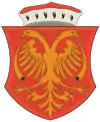 |
-en.svg.png.webp) |
Serbian Despotate | 1402-1459 | The Serbian Despotate (Serbian: Српска деспотовина / Srpska despotovina) was a medieval Serbian state in the first half of the 15th century. Although the Battle of Kosovo in 1389 is generally considered the end of the medieval Serbia, the Despotate, a successor of the Serbian Empire and Moravian Serbia, survived for another 60 years, experiencing a cultural and political renaissance before it was conquered by the Ottomans in 1459. Before its conquest the Despotate nominally had a suzerain status to the Ottoman Empire, Byzantine Empire and Kingdom of Hungary. After being fully subjugated to the Ottoman Empire in 1459, it continued to exist in exile in the medieval Kingdom of Hungary until the mid-16th century. Pavle Bakić was the last Despot of Serbia to be recognized by both the Ottoman and the Habsburg Empires. |
Modern History
| Image | Map | Name | Years | Notes |
|---|---|---|---|---|
 |
State of Jovan Nenad | 1526-1527 | Jovan Nenad (Serbian Cyrillic: Јован Ненад; ca. 1492 – 26 July 1527), known as the Black was a Serb military commander in the service of the Kingdom of Hungary who took advantage of a Hungarian military defeat at Mohács and subsequent struggle over the Hungarian throne to carve out his own state in the southern Pannonian Plain. He styled himself emperor (tsar). Jovan Nenad is attributed by Serbian historians as the founder of Vojvodina and the leader of the last independent Serbian state before the Ottoman conquest. | |
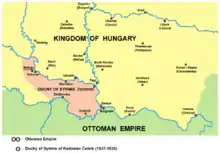 |
Duchy of Syrmia of Radoslav Čelnik | 1527–1532 | Radoslav Čelnik (Serbian Cyrillic: Радослав Челник, Hungarian: Radoszláv Cselnik; fl. 1526–1532), known as Vojvoda Rajko (војвода Рајко), was a Serb general (vojvoda) in the army of Jovan Nenad, the titular Serbian Emperor who held present-day Vojvodina, who after the death of Jovan Nenad (1527) took part of the army from Bačka to Syrmia and acceded into Ottoman service. Radoslav then ruled over Syrmia as "Duke of Syrmia (Srem)", initially as an Ottoman vassal (1527–1530) and then as a Habsburg vassal (1530–1532), until the region was conquered by the Ottomans. His residence and capital was in Slankamen. | |
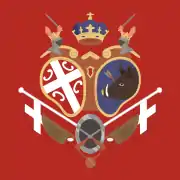 |
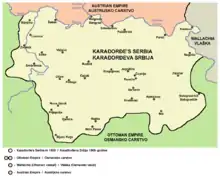 |
Revolutionary Serbia | 1804-1813 | Revolutionary Serbia (Serbian: Устаничка Србија / Ustanička Srbija) or Karađorđe's Serbia (Карађорђева Србија / Karađorđeva Srbija) refers to the state established by Serbian revolutionaries in Ottoman Serbia (Sanjak of Smederevo) after successful military operations against the Ottoman Empire and establishment of government in 1805. The Sublime Porte first officially recognized the state as autonomous in January 1807, however, the Serbian revolutionaries rejected the treaty and continued fighting the Ottomans until 1813. Although the first uprising was crushed, it was followed by the Second Serbian Uprising in 1815, which resulted in the creation of the Principality of Serbia, as it gained semi-independence from the Ottoman Empire in 1817. |
.svg.png.webp) |
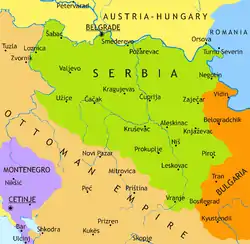 |
Principality of Serbia | 1815-1882 | The Principality of Serbia (Serbian: Кнежевина Србија / Kneževina Srbija) was a semi-independent state in the Balkans that came into existence as a result of the Serbian Revolution, which lasted between 1804 and 1817. Its creation was negotiated first through an unwritten agreement between Miloš Obrenović, leader of the Second Serbian Uprising and Ottoman official Marashli Pasha. It was followed by the series of legal documents published by the Porte in 1828, 1829 and finally, 1830 — the Hatt-i Sharif. Its de facto independence ensued in 1867, following the expulsion of all Ottoman troops from the country; its independence was recognized internationally in 1878 by the Treaty of Berlin. In 1882 the country was elevated to the status of kingdom. |
.svg.png.webp) |
.svg.png.webp) |
Kingdom of Serbia | 1882-1918 | The Kingdom of Serbia (Serbian: Краљевина Србија / Kraljevina Srbija) was created when Milan I, ruler of the Principality of Serbia, was proclaimed king in 1882. Since 1817, the Principality was ruled by the Obrenović dynasty (replaced by the Karađorđević dynasty for a short time). The Principality, suzerainty of the Ottoman Empire, de facto achieved full independence when the last Ottoman troops left Belgrade in 1867. The Congress of Berlin in 1878 recognized the formal independence of the Principality of Serbia, and in its composition Nišava, Pirot, Toplica and Vranje districts entered the South part of Serbia. In 1882, King Milan I proclaimed the Kingdom of Serbia and maintained a foreign policy friendly to Austria-Hungary. |
Special administrative divisions in former foreign countries with high degree of autonomy
| Image | Map | Name | Years | Notes |
|---|---|---|---|---|
.svg.png.webp) |
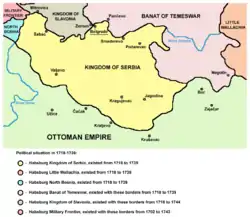 |
Kingdom of Serbia | 1718-1739 | The Kingdom of Serbia (Serbian: Краљевина Србија / Kraljevina Srbija, German: Königreich Serbien, Latin: Regnum Serviae) was a province (crownland) of the Habsburg Monarchy from 1718 to 1739. It was formed from the territories to the south of the rivers Sava and Danube, corresponding to the Sanjak of Smederevo (or "Belgrade Pashalik"), conquered by the Habsburgs from the Ottoman Empire in 1717. It was abolished and returned to the Ottoman Empire in 1739. During this Habsburg rule, Serbian majority did benefit from self-government, including an autonomous militia, and economic integration with the Habsburg monarchy — reforms that contributed to the growth of the Serb middle class and continued by the Ottomans "in the interest of law and order". |
| New Serbia | 1752-1764 | New Serbia (Ukrainian: Нова Сербія, translit. Nova Serbija; Russian: Новая Сербия; Serbian: Нова Србија / Nova Srbija; archaic Serbian name: Нова Сербія or Ново-Сербія; Romanian: Noua Serbie) was a military frontier of Imperial Russia from 1752 to 1764 subordinated directly to the Senat and Military Collegium. It was mostly located in the territory of present-day Kirovohrad Oblast of Ukraine, although some of its parts were located in the territory of present-day Cherkasy Oblast, Poltava Oblast and Dnipropetrovsk Oblast. The administrative centre of New Serbia was Novomirgorod (literally "New Mirgorod"), which is now Novomyrhorod, Ukraine. | ||
 |
Slavo-Serbia | 1753-1764 | Slavo-Serbia (Ukrainian: Слов’яносе́рбія; Serbian: Славеносрбија or Slavenosrbija; archaic Serbian name: Славено-Сербія) was a territory of Imperial Russia between 1753-64. It was located by the right bank of the Donets River between the Bakhmutka (Бахмут) and Luhan (Лугань) rivers. This area today constitutes the territories of present-day Luhansk Oblast and Donetsk Oblast of Ukraine. The administrative centre of Slavo-Serbia was Bakhmut (Bahmut). | |
.svg.png.webp) |
 |
Koča's frontier | 1788-1792 | Koča's frontier (Serbian: Кочина крајина / Kočina krajina) refers to the Serbian territory established in the Sanjak of Smederevo, Ottoman Empire, during the Austro-Turkish War (1787–91). The Habsburg-organized Serbian Free Corps, among whom Koča Anđelković was a prominent captain (hence the historiographical name), initially held the central part of the sanjak, between February and September 7, 1788; after the Austrians entered the conflict the territory was expanded and became a Habsburg protectorate under military administration, called Serbia (German: Serbien). After the Austrian withdrawal and Treaty of Sistova (1792), the territory was regained by the Ottomans. |
 |
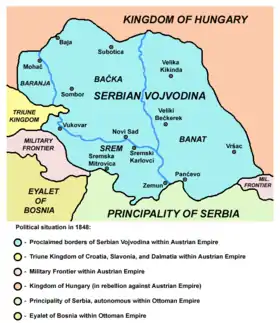 |
Serbian Vojvodina | 1848-1849 | The Serbian Vojvodina (Serbian: Српска Војводина / Srpska Vojvodina) was a short-lived self-proclaimed Serb autonomous province within the Austrian Empire during the Revolutions of 1848, which existed until 1849 when it was transformed into the new (official) Austrian province named Voivodeship of Serbia and Banat of Temeschwar. |
 |
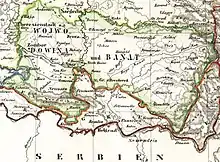 |
Voivodeship of Serbia and Banat of Temeschwar | 1849-1860 | The Voivodeship of Serbia and Banat of Temeschwar or Serbian Voivodeship and the Banate of Temes (German: Woiwodschaft Serbien und Temeser Banat), known simply as the Serbian Voivodeship (Serbische Woiwodschaft), was a province (duchy) of the Austrian Empire that existed between 1849 and 1860. It was a separate crown land named after two former provinces: Serbian Vojvodina and Banat of Temes. Its former area is now divided between Serbia, Romania and Hungary. The Voivodeship gave its name to the present Serbian Autonomous Province of Vojvodina. |
.svg.png.webp) |
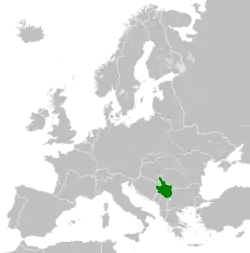 |
Territory of the Military Commander in Serbia | 1941-1944 | The Territory of the Military Commander in Serbia (Serbian: Подручје Војног заповједника у Србији / Područje vojnog zapovjednika u Srbiji) was the area of the Kingdom of Yugoslavia that was placed under a military government of occupation by the Wehrmacht following the invasion, occupation and dismantling of Yugoslavia in April 1941. |
Short lived political entities
- Rastislalić Domain (14th century)
- Radoslav Hlapen Domain (14th century)
- Empress Helena Domain (14th century)
- Banat Republic (1918)

- Serb-Hungarian Baranya-Baja Republic (1921)

- Republic of Serbian Krajina (1991-1995)
.svg.png.webp)
- Republika Srpska (1992-1995)

- Eastern Slavonia, Baranja and Western Syrmia (1995-1998)

Present political entities
| Image | Map | Name | Year |
|---|---|---|---|
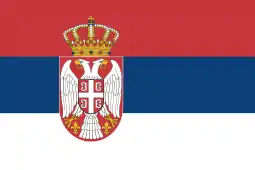 |
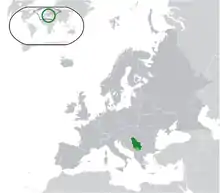 |
Serbia | 2006 |
Diaspora
References
- Vuković & Vemić 2014.
- "Elements Of Ethnic Identification Of The Serbs" (PDF): 727. Cite journal requires
|journal=(help) - Dejan Jović (January 2009). Yugoslavia: A State that Withered Away. Purdue University Press. pp. 135–. ISBN 978-1-55753-495-8.
- latimes (May 22, 2014). "latimes". Retrieved May 22, 2014.
- "Information on the status of Serbian people in the neighbouring countries, Ministry for Diaspora, Republic of Serbia". Archived from the original on 2007-11-24. Retrieved 2007-05-15.
Sources
- Primary sources
- Moravcsik, Gyula, ed. (1967) [1949]. Constantine Porphyrogenitus: De Administrando Imperio (2nd revised ed.). Washington D.C.: Dumbarton Oaks Center for Byzantine Studies. ISBN 9780884020219.
- Pertz, Georg Heinrich, ed. (1845). Einhardi Annales. Hanover.
- Scholz, Bernhard Walter, ed. (1970). Carolingian Chronicles: Royal Frankish Annals and Nithard's Histories. University of Michigan Press. ISBN 0472061860.
- Thurn, Hans, ed. (1973). Ioannis Scylitzae Synopsis historiarum. Berlin-New York: De Gruyter. ISBN 9783110022858.
- Шишић, Фердо, ed. (1928). Летопис Попа Дукљанина (Chronicle of the Priest of Duklja). Београд-Загреб: Српска краљевска академија.
- Кунчер, Драгана (2009). Gesta Regum Sclavorum. 1. Београд-Никшић: Историјски институт, Манастир Острог.
- Живковић, Тибор (2009). Gesta Regum Sclavorum. 2. Београд-Никшић: Историјски институт, Манастир Острог.
- Montenegrin Census' from 1909 to 2003
- The Ethnic Structure of the Population in Montenegro
- "Petar I Petrovic' - DJELA" publisher CID Podgorica 1999 year, printed by "Vojna tamparija" - Beograd
- "Statistički Godišnjak 2006" - Statistical Office of Montenegro
- Stojanović, Ljubomir (1934). Stare srpske povelje i pisma: 1,2. Srpska školska knjiga.
- Secondary sources
- Bataković, Dušan T., ed. (2005). Histoire du peuple serbe [History of the Serbian People] (in French). Lausanne: L’Age d’Homme. ISBN 9782825119587.
- Vuković, Nebojša; Vemić, Mirčeta (1 April 2014), "Position of the Serbian lands", History and geography: meetings and permeations, САНУ, pp. 123–, ISBN 978-86-7005-125-6
- Živković, Tibor (2013). "The Urban Landscape of Early Medieval Slavic Principalities in the Territories of the Former Praefectura Illyricum and in the Province of Dalmatia (ca. 610-950)". The World of the Slavs: Studies of the East, West and South Slavs: Civitas, Oppidas, Villas and Archeological Evidence (7th to 11th Centuries AD). Belgrade: The Institute for History. pp. 15–36. ISBN 9788677431044.